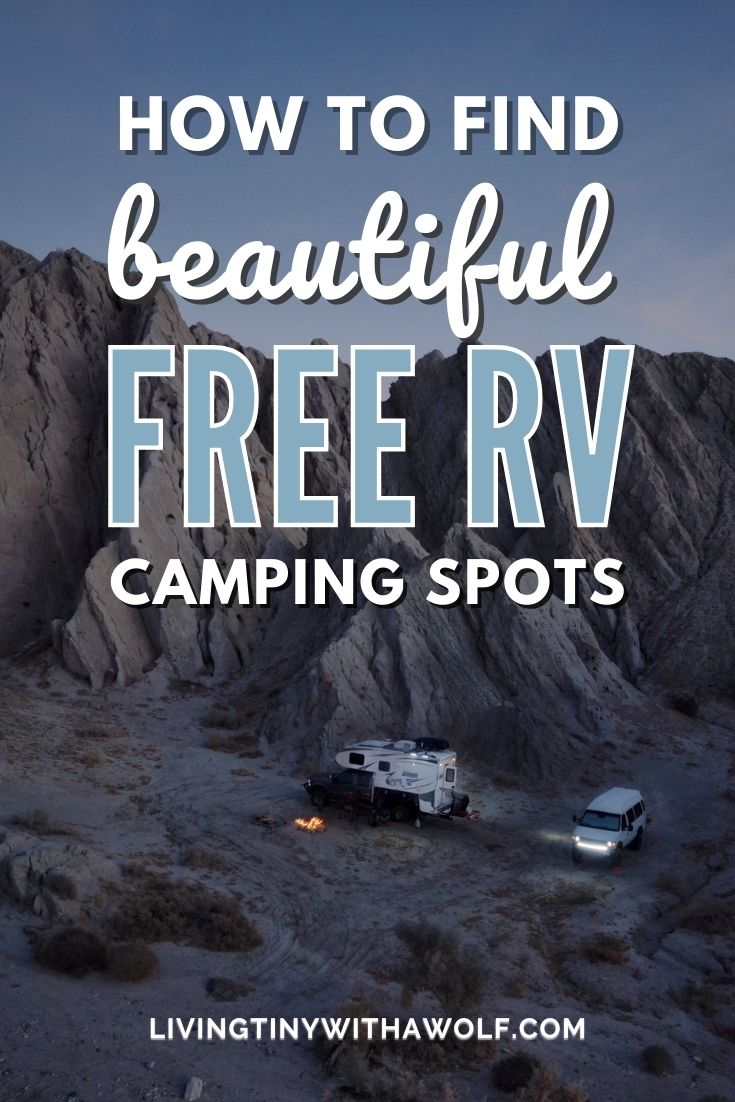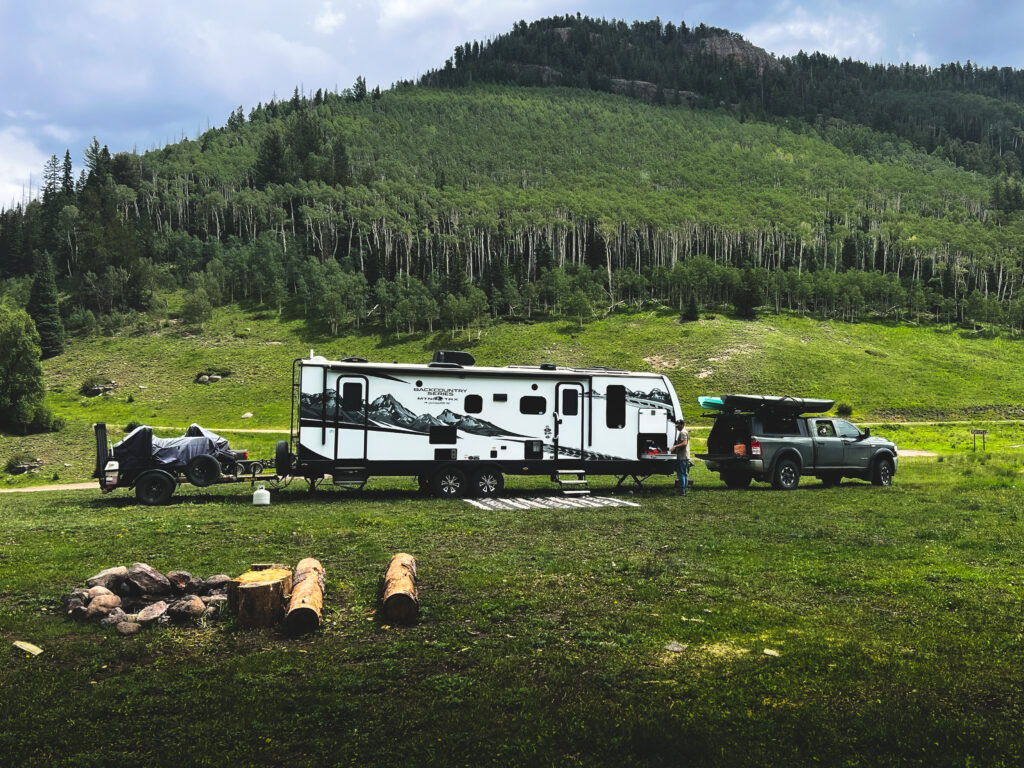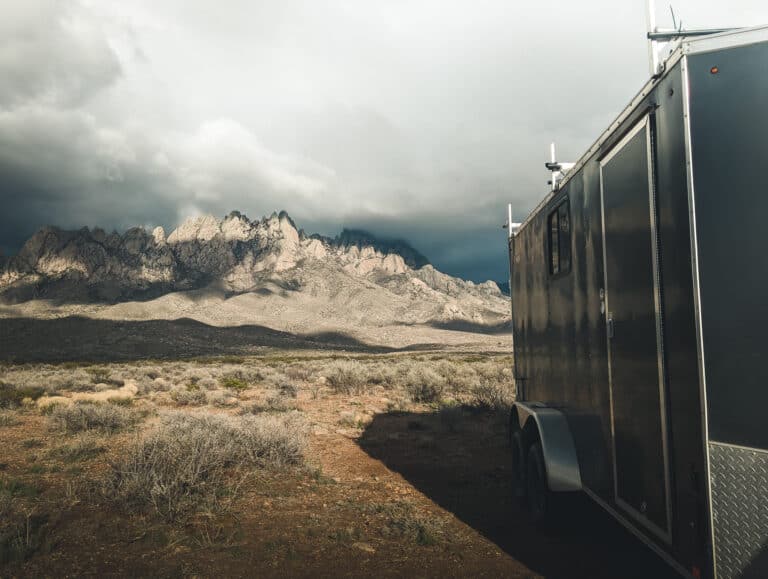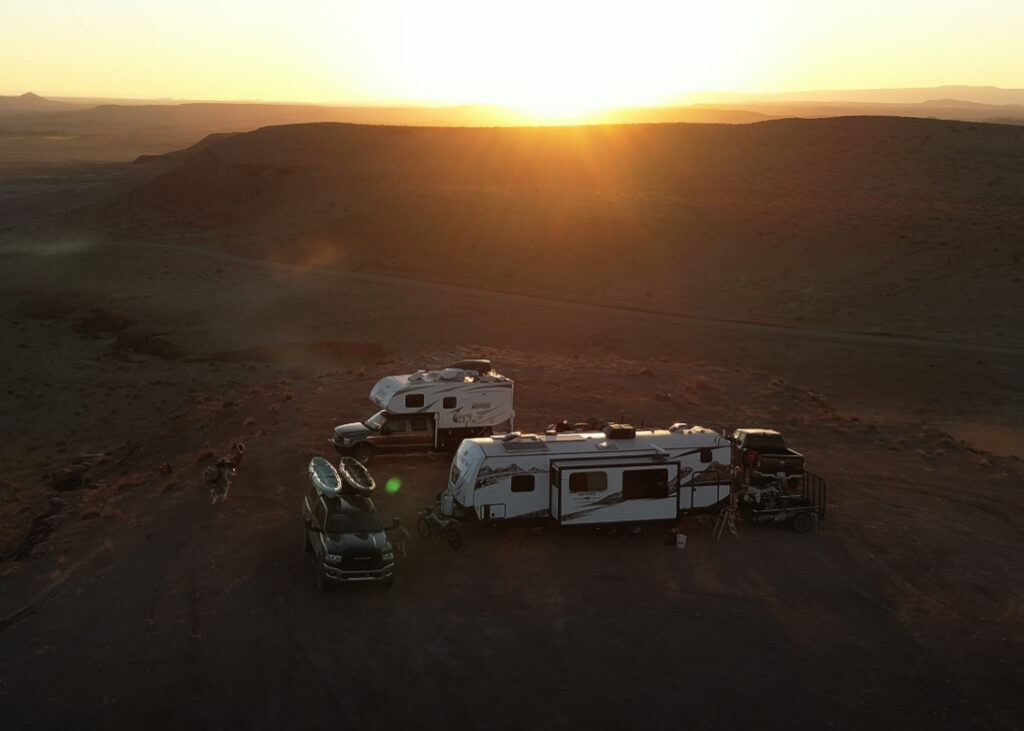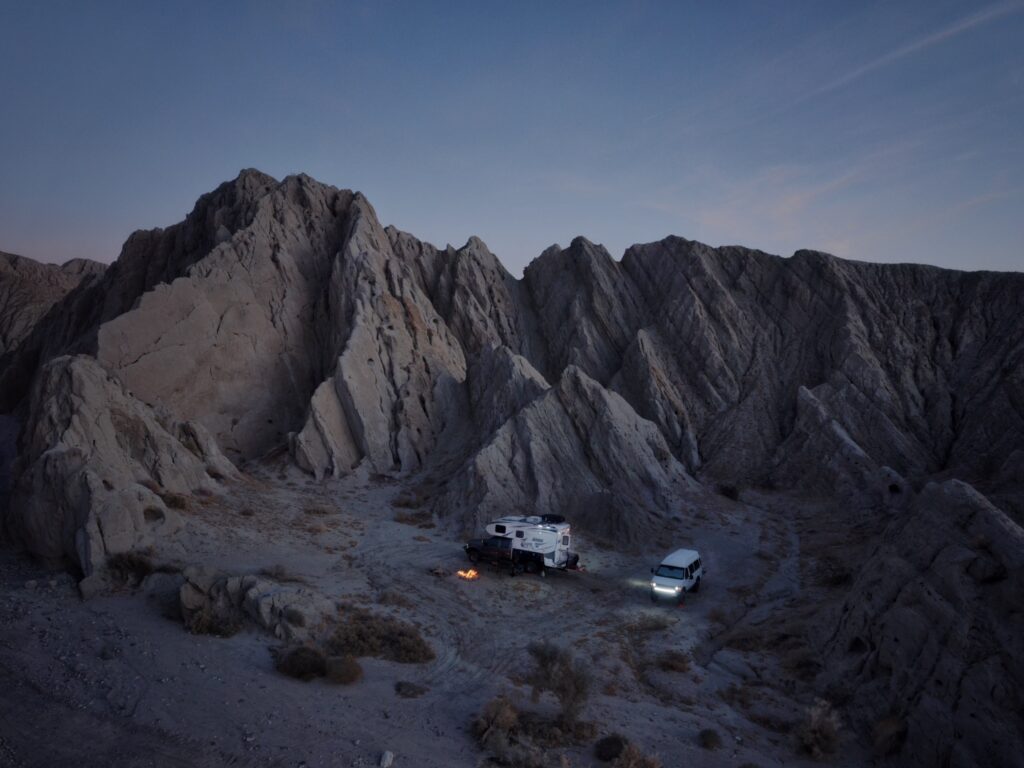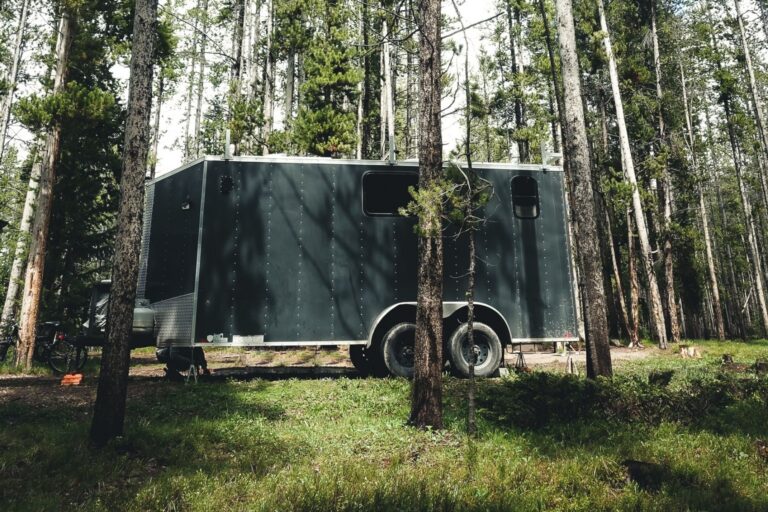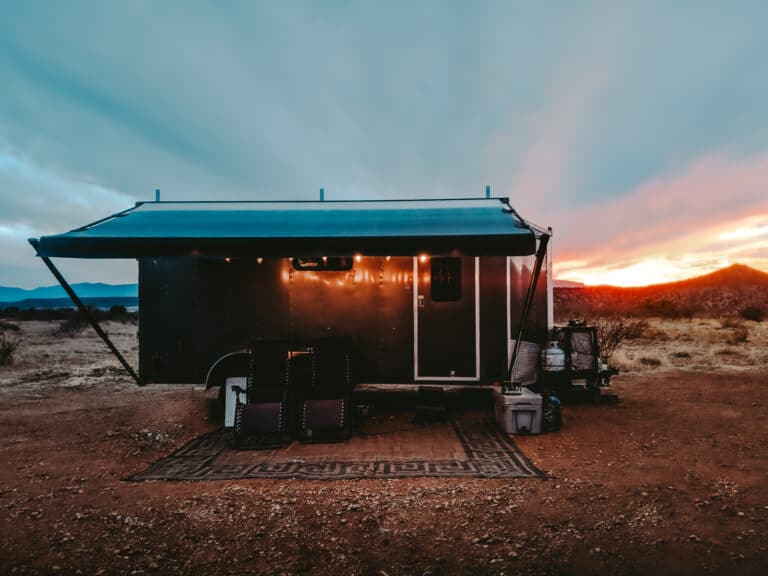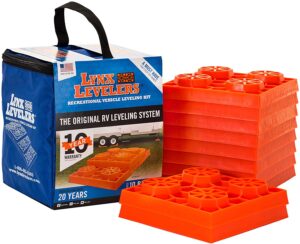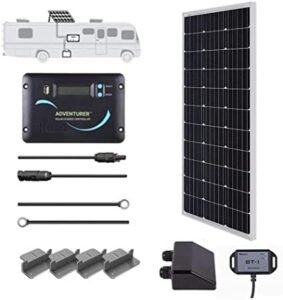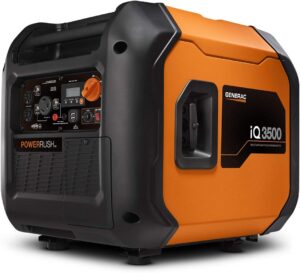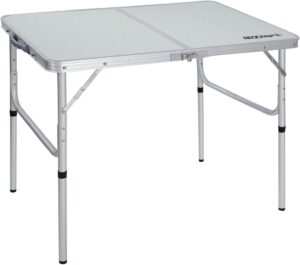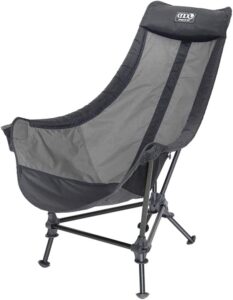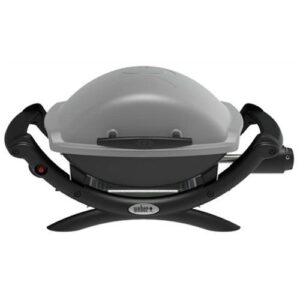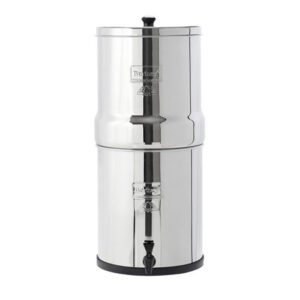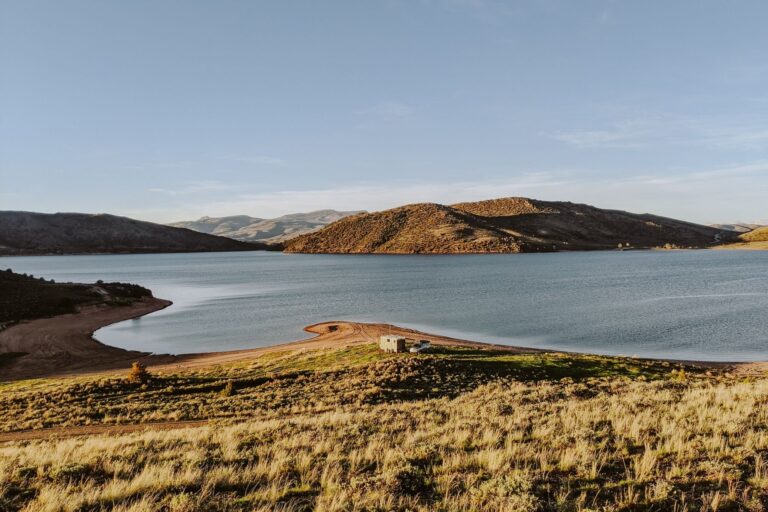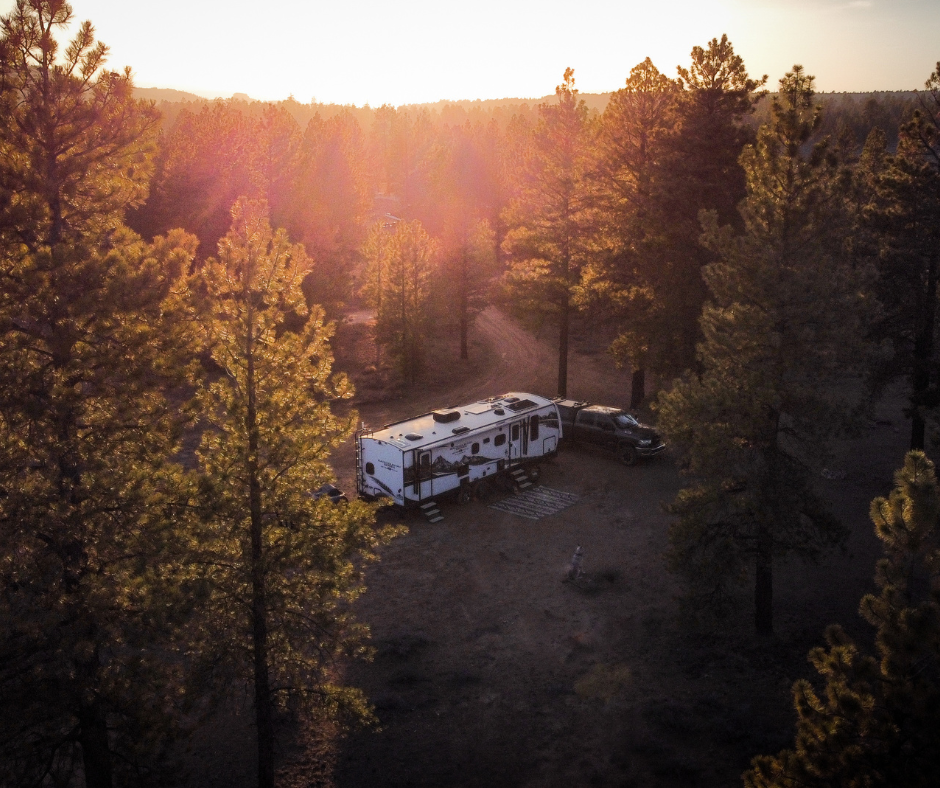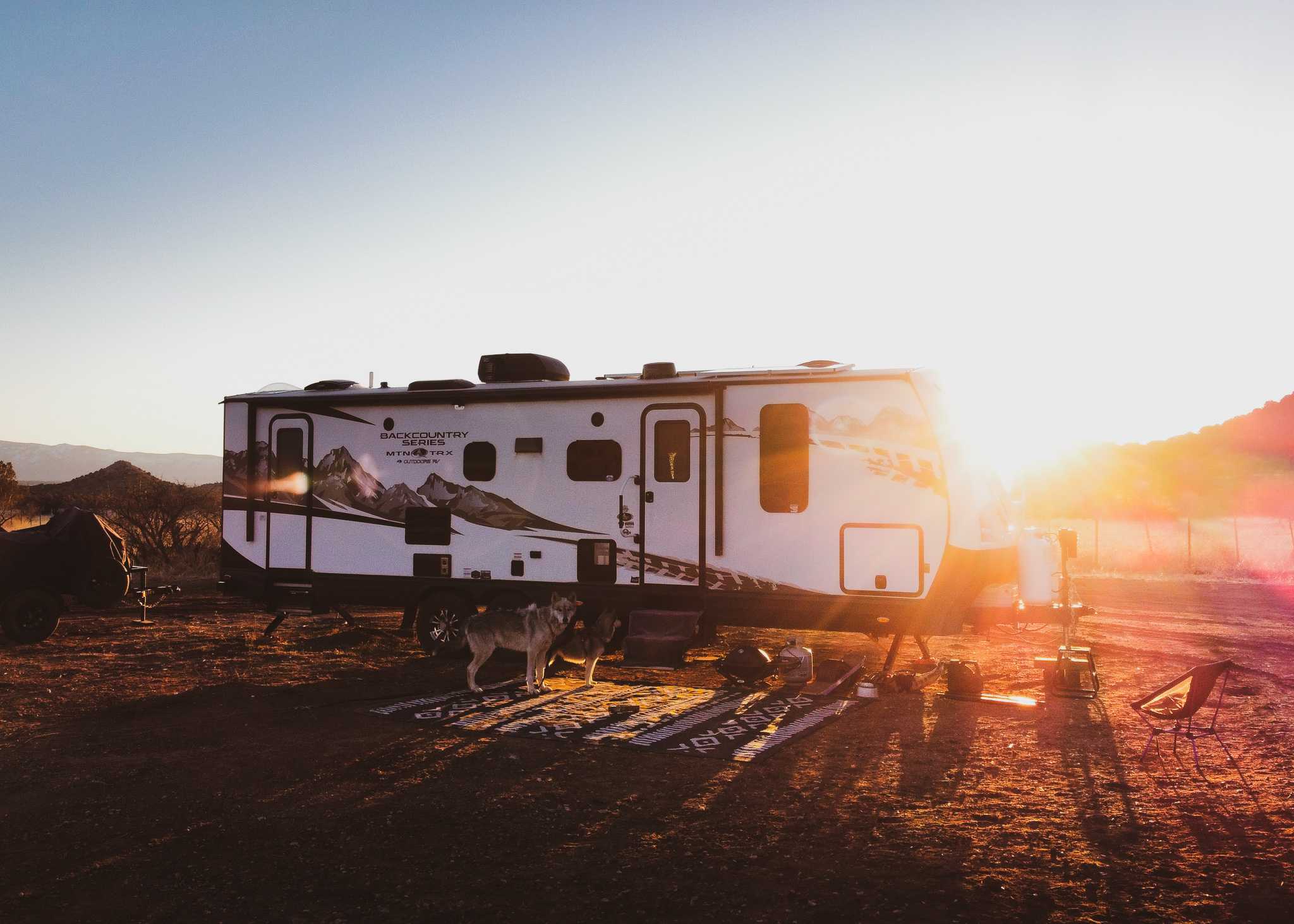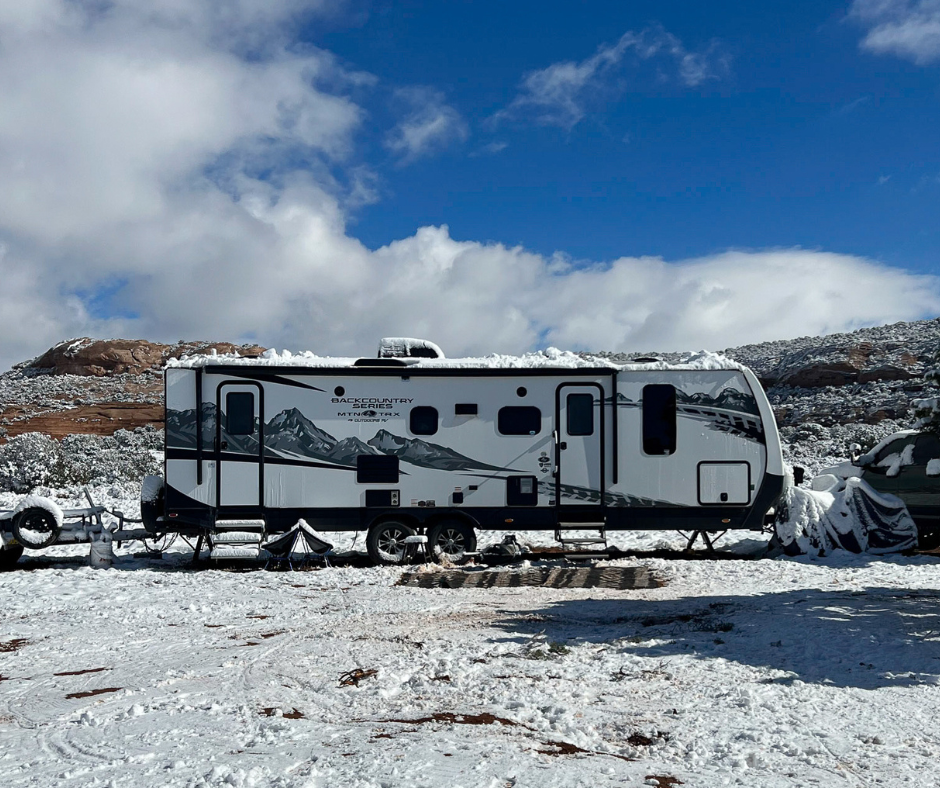How Full-Time RVers Find Beautiful + Free RV Camping in the US

Table of Contents
ToggleHow Full-Time RVers Make Free Camping a Reality
For full-time RVers, finding affordable and convenient camping options is crucial to making the lifestyle sustainable.
Being full-time RVers ourselves since 2019, we quickly learned how expensive campgrounds can be. Paying anywhere from $10-65+ dollars every night, the costs of camping can add up quickly!
But did you know, there are public lands all over the US where you can camp for zero dollars? We’ve made it our mission to seek out and share our top tips on finding incredible free boondocking campsites all over the US.
In this post, we are going to show you exactly how we find amazing boondocking campsites for FREE!
Learn about the apps we use to find free camping, (they are seriously awesome + user friendly) plus everything you need to know about boondocking, what to expect, and the exact gear to bring.
Why Free RV Camping Is a Great Option for Full-Time Rvers
There are a ton of reasons to camp for free! Besides enjoying incredible landscapes, did I mention it’s completely free? If you’re not already convinced, here are some more reasons to try boondocking.
Cost savings: One of the biggest advantages is that it’s a fantastic way to save some serious cash, allowing you to put that extra money towards other fun adventures. Rather than paying for a traditional campground, boondocking allows you to save money and put those funds towards other exciting experiences.
No more worrying about reservations: With free camping, you can roll up to a location and set up camp without having to worry about booking in advance. This gives you the freedom to be spontaneous and go wherever the road takes you.
Unique and remote camping locations: Dispersed camping locations are often more secluded than traditional campgrounds, so you can escape the crowds and enjoy some solitude. Imagine waking up to the sound of birds chirping and the breeze rustling through the trees. Hello, blissful solitude.
Community building opportunities: Free RV camping is also a great way to connect with other like-minded travelers and build a sense of community on the road. You may find yourself swapping stories and tips with other full-time RVers. Who knows, you may even make lifelong friends along the way. I know we have!
What is “Free Camping?”
“Free camping”, also known as boondocking, dry camping, and dispersed camping- is where you park your RV on public lands (usually, BLM or National Forest) without hookups or amenities.
This means, you will not have access to electricity, water, bathrooms, or picnic tables. So, before you decide to park in the middle of nowhere, make sure your rig is ready for an off-grid adventure.
There are a ton of names used to describe free camping. And each has a slightly different meaning. Here’s a brief description of each one:
Dispersed camping: Official term used by government agencies (National Forest Service and Bureau of Land Management) to describe free camping locations across the US.
Boondocking: This term is used among RVers mostly to describe free camping without any hookups or amenities in undeveloped areas.
Dry Camping: Staying at a campground without hookups, with more emphasis on the fact that there are no amenities with this type of camping.
Stealth Camping: Discreetly camping in urban areas (parking lots, neighborhoods, etc.) and not being noticed.
Want to learn more about boondocking in your RV? Check out our complete Guide to RV Boondocking!
Understanding the Laws Surrounding Free RV Camping
Alright, let’s dive into the legal side of free RV camping—but don’t worry, it’s not as boring as it sounds. Understanding the laws and regulations surrounding free camping is crucial to avoid any legal trouble and make sure you’re camping in safe and legal areas. Here are some key things to know:
Federal laws and regulations: When it comes to free RV camping on federal land, you’re in luck! Most federal land allows free dispersed camping, which means camping outside of designated campgrounds. However, be sure to check with the specific agency managing the land for any restrictions or regulations.
State and local laws and regulations: State and local laws vary greatly when it comes to free RV camping. Some states allow dispersed camping on state land, while others may have restrictions or require permits. It’s essential to research the specific laws and regulations for the state or area you’re planning to camp in.
Types of public lands where free RV camping is allowed
National Forests: National Forests offer some of the best free dispersed camping opportunities in the country. With over 193 million acres of public land, you can find National Forest camping in almost every state. Although not all National Forests allow free camping. Most National Forests have designated areas where you can camp for free as long as you follow the rules and regulations. You can usually find these sites by checking with the ranger station or by looking at a National Forest map. Some National Forests may also require a permit or have seasonal closures, so be sure to do your research before heading out.
Bureau of Land Management (BLM): BLM lands are another great option for free dispersed camping. BLM lands make up over 245 million acres in the United States, with most of it located in the western states. Like National Forests, BLM lands have designated areas where you can camp for free, as long as you follow the rules and regulations. BLM land is usually on open, desert landscapes. You can camp free on BLM areas for 14 days, but can be shorter depending on location.
Wildlife Management Areas (WMA): WMAs are public lands managed by state wildlife agencies for the purpose of conserving and managing wildlife populations. Many WMAs offer free dispersed camping opportunities, although the availability may vary by state and season. Check with the local wildlife agency or by looking at a WMA map to find out more information.
Army Corps of Engineers (COE): The COE manages thousands of acres of public lands, including campgrounds and recreation areas. While many of these sites do have a fee, there are some areas where you can camp for free. Check with the local COE office or by looking at a COE map to find out more information.
What To Expect When Free RV Camping
First off, it’s important to set expectations and know that while you may come across some seriously amazing free campsites, others may not be as impressive. But that’s part of the adventure, right?
When it comes to amenities and hookups, it’s safe to say that you won’t find any at free camping sites. That means you’ll need to be prepared to be self-sufficient and bring everything you need. Here’s what you can expect:
- No public bathrooms/showers: You’ll need to plan ahead and bring your own portable toilet or find a way to dispose of your waste properly.
- No potable water hookups: You’ll need to bring your own water or plan to fill up at a nearby potable water source. Be sure to bring a water filter or purification tablets if necessary.
- No trash cans: You’ll need to pack out all your trash and dispose of it properly to leave the site clean and pristine for the next camper.
- No picnic tables: You’ll need to bring your own camping chairs and tables if you want to have a comfortable place to sit and eat.
- No fire rings: If you plan on having a fire, you’ll need to build your own fire pit or use a portable propane stove instead.
- No electricity: You’ll need to rely on your RV’s batteries or bring a portable generator to power any necessary appliances.
- No cell service: Many free campsites are off the beaten path, meaning you may not have any cell signal. Learn more about how we get internet while on the road.
Despite the lack of amenities, free RV camping can provide a sense of freedom and adventure that you won’t find at traditional campgrounds. So, embrace the challenge of being self-sufficient and enjoy the unique experiences that free camping has to offer! Just remember to leave your campsite clean and pristine, so the next camper can enjoy it as much as you did.
Popular Apps for Finding Boondocking Locations
Apps are a game-changer for full-time RVers searching for boondocking locations. They offer convenience, information, and user feedback that make finding the perfect spot a breeze. Here are some reasons why apps are so helpful:
- Convenience: With just a few taps on your phone or tablet, you can quickly find free camping spots near your location or along your route.
- Information: Many apps provide details on the size of the camping spot, accessibility, and amenities such as toilets, water sources, and cell phone coverage.
- User feedback: User reviews and ratings of boondocking locations offer valuable insights into the quality of the camping spot, potential issues, and even tips on how to access the location.
We have compiled a list of up-to-date resources/apps we use most frequently to find free camping near me when we are traveling across the country.
Campendium
IOS App | Website | Free
As a full-time RVer, I rely on several apps to find boondocking locations. My favorite is Campendium, which boasts over 27,000 user-submitted campsites across North America on its website and IOS app. The app provides an interactive map that shows images, reviews, dump stations, and cell signal strength.
iOverlander
IOS & Android App | Website | Free
iOverlander is a free website that also offers an app that helps travelers find campsites and access information without cell signal. Since it is user-based, it is always being updated with current information by the community that uses it.
iOverlander allows you to add a campsite to the map with photos and describe the details of the location including water access, cell signal strength and condition of the road and more.
It also includes filters that helps you access different information like gas stations nearby, laundromats, places to dump your tanks and fill up on water- which is incredibly helpful.
It is an extremely comprehensive app that is becoming more popular as more users add and update information.
Free Roam
IOS & Android Apps | Website | Free
FreeRoam is a non-profit company with the goal of connecting campers with nature in a sustainable way. FreeRoam has a free desktop and mobile app with helpful filters and an offline mode that helps its users find free campsites on public land with a directory of reviews for established campsites.
The app includes over 20,000 boondocking sites across the US, Canada, and Mexico, making it a valuable resource for RVers looking to explore new areas. In addition, Free roam has a feature that none of the other apps have, like crowdedness, noise, shade, cleanliness, safety and road condition.
Free roam also shows photos of most campsites so you can see what the area looks like before you go.
Other apps that can be helpful for finding boondocking locations
Freecampsites.net
As the name suggests, this app helps you find free campsites across the country. The app features a map of all the free camping locations, complete with reviews and photos from other campers. You can also filter your search by amenities, such as water, toilets, and fire pits.
The Dyrt
This app is a great all-in-one resource for camping and RVing. It features a database of over 1 million campsites across the country, including boondocking spots. You can search for sites by location, activities, and amenities, and you can also read reviews and see photos from other campers.
All Stays
This app is a must-have for any boondocker. It features a comprehensive database of campgrounds, RV parks, and other camping spots, including free boondocking locations. You can filter your search by amenities, such as showers, Wi-Fi, and pet-friendly sites. Plus, AllStays is constantly updated with new locations and reviews from fellow travelers.
Boondocking.org
This app is a treasure trove of information for boondockers. It’s a community-driven site that features user-submitted locations, complete with GPS coordinates and reviews. You can search for spots by state, type of location, and other criteria. And best of all, it’s completely free to use!
Harvest Hosts
This app is a bit different than the others on this list, but it’s definitely worth mentioning. Harvest Hosts is a membership program that lets you camp for free at wineries, farms, and other unique locations across the country. The app features a map of all the participating hosts, as well as their contact information and amenities.
Hip Camp
This app is perfect for those who want to find boondocking spots on private land. Hipcamp lets you search for unique camping experiences, from secluded cabins to private campsites on farms and ranches. You can filter your search by activities, such as hiking, fishing, and kayaking, and you can read reviews from other campers to find the perfect spot for your next adventure.
Other Resources for Finding Free Camping
Google Maps
As a full-time RVer, I’ve found that Google Maps is an incredibly helpful tool when looking for a place to camp. One feature that I find particularly useful is the Street View feature, which allows me to get a virtual view of the campsite before arriving. By checking Street View, I can confirm that a campsite is large enough to accommodate my 28-foot RV, and even see other big-rigs parked in a potential camping spot, giving me the confidence that I’ll fit comfortably.
Rules of dispersed camping
Dispersed camping is a great way to get off the beaten path and experience the beauty of nature. But, it’s important to follow the rules to protect the environment and ensure that others can enjoy the area too. Here are some rules to keep in mind:
- Keep your campsite away from water: To protect the water and wildlife, it’s important to keep your campsite at least 100 feet away from water sources. This helps prevent pollution and keeps the water clean for drinking and recreational use.
- Pack everything out with you: When dispersed camping, there are no trash cans or facilities, so it’s important to pack everything out with you. This means leaving no trace and disposing of your waste properly.
- Follow fire ban restrictions: Depending on the area and time of year, there may be fire restrictions in place. It’s important to follow these rules to prevent wildfires and keep everyone safe. Bring a camp stove for cooking instead.
- Dig a hole for waste: If you need to go to the #2 in the forest, dig a hole at least 6 inches deep to bury your waste. Also, dispose of toilet paper properly by putting it in a trash bag and packing it out with you.
Our Tips for Free RV Camping
Alright, let’s talk about some tips for finding free RV camping that will help you have the best experience possible! Here are some things to keep in mind:
- Plan ahead and research potential sites: It’s important to do your research ahead of time and identify potential free camping sites. Use online resources like the Bureau of Land Management website, freecampsites.net, or the iOverlander app to find free camping areas. Check out reviews and photos from other campers to get an idea of what to expect.
- Arrive early to secure a spot: Since free camping areas are first-come, first-served, it’s essential to arrive early to secure a spot. Especially on weekends and holidays, popular free camping areas can fill up quickly. So, plan to arrive early in the day to secure a spot and avoid the disappointment of arriving too late.
- Be aware of your surroundings: Always be aware of your surroundings and pay attention to any changes in the environment. This includes weather conditions, wildlife activity, and any other potential hazards such as wildlife, flooding, or dangerous terrain.
- Practice campfire safety: Roast marshmallows, not your RV. If you plan on having a campfire, make sure to follow all campfire safety guidelines. Keep the fire contained and make sure it is completely extinguished before leaving.
- Secure your RV: When camping in an unfamiliar area, make sure to secure your RV. Lock all doors and windows, and consider using a security system if available.
Respect the environment and other campers: Free camping areas can provide a unique and secluded camping experience, but it’s important to respect the environment and other campers. Don’t disturb the natural surroundings or wildlife, and keep noise levels down to avoid disturbing other campers. Also, be sure to follow any posted rules or regulations to avoid any legal trouble.
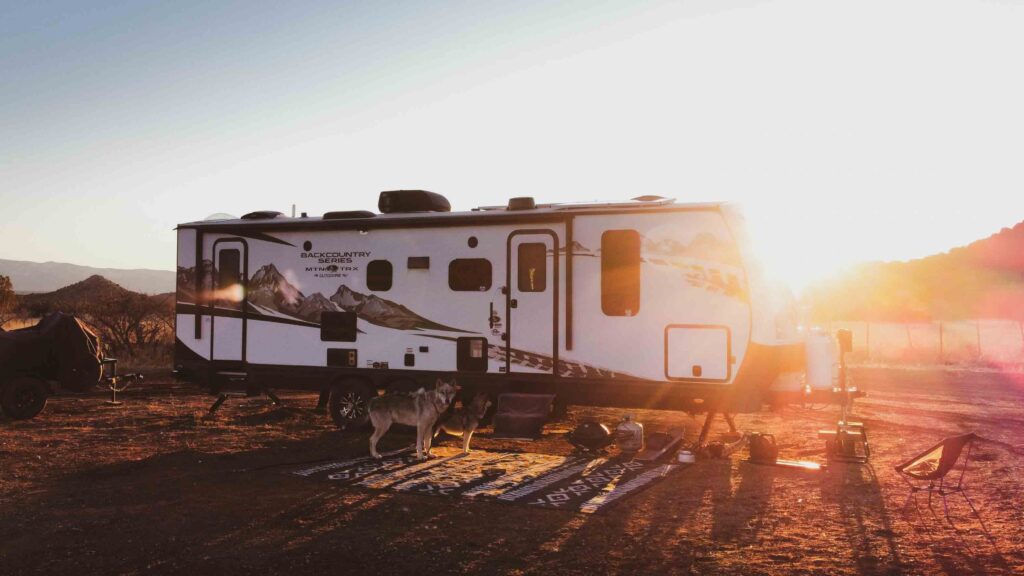
Free Camping Frequently Asked Questions
Before you head out to your free camp spot for the night, there are a few frequently asked questions new campers wonder about.
How Long Can I Camp For Free?
Most free campsites in the US allow you to stay for 14-16 days at a time. If it is more popular, they might only allow 3-5 days while other, more remote areas allow up to 16+ days.
Double-check the signage and stay within the guidelines to ensure these locations stay open to the public for years to come.
What are the Cons of Free Camping?
- Some free campsites will require a lot of driving and 4×4 roads.
- You may run into trashed campsites. (since there’s no one to enforce rules, some visitors do not clean up after themselves).
- No amenities or hookups—this means you will have to come to camp prepared with water and be self-contained.
Where Can I Camp for Free in the City?
Besides camping in the woods, there are alternatives for travelers to stay overnight. These locations offer their parking lots free of charge.
- Casinos: Most casinos offer overnight RV parking. Their parking lots are great for staying a night because they usually have huge parking lots that are lit well.
- Walmart: Walmarts allow up to 24 hours at a time in (almost) any of their parking lots. It’s the perfect option for stocking up on groceries or supplies. However, many Walmarts near popular outdoor recreation areas do not allow overnight camping as a result of past misuse and overpopulation during the busy tourist season. Find a list of no-camp WalMarts here.
- Truck Stops: Many truck stops and rest areas are completely fine with RVers staying overnight. Usually, truck stops are first-come-first-serve and can get quite loud, but it’s an option when you are in a pinch. Here is a website that shares all the rest stops around the United States.
- Cabela’s: at select stores, Cabelas provides designated RV parking for their customers.
Cracker Barrel: a popular eatery that allows overnight RV parking at select locations.
Learn about 20 places in the US that allow overnight camping for free.
Free Camping Essential RV Gear for Full Time-RVers
No one tells you what you really need when you go boondocking for the first time. Don’t go boondocking without this essential gear! (your free camping trip will be more convenient with these items, trust me).
Leveling Blocks + Level: No matter where you camp for free, you WILL be on unlevel ground. We use these leveling blocks at every camp spot we find. Make sure to grab a level so you know when your RV is level.
Solar Panel Kit: How much solar you need depends on the amount of power you use on a daily basis. Do you have to charge a lot of phones, cameras and other gear?
Folding Table: Even if you have an RV, camping is meant for you to spend your time outside. Bring a table with an adjustable height so you can eat outside, play games, etc.
Folding Camp Chairs: Sitting around the campfire or table for dinner means you will need a comfortable chair.
Portable Barbecue Grill: We love grilling outside when we camp for free. Having a portable grill makes cooking easier!
Berkey Water Filter: Instead of bringing a bunch of single use plastic water bottles, try a Berkey filter for fresh drinking water wherever you go!
Leave no Trace when Free Camping
Camping for free comes with responsibility. Make sure you follow the leave no trace principles when you are camping on public lands. We want to keep these wild places beautiful for years to come. Clean up your trash and put your fire out when you are done with it. Please read the list below and so your best to leave it how (or better than) you found it.
- Dispose of waste properly
- Pack out what you Pack in (do not litter)
- Build campfires in an established fire ring
- Travel and Camp on durable surfaces
- Respect Wildlife
- Be considerate of other campers
- Plan ahead and be prepared
Together we can help minimize our impact on the environment and make wild spaces a place for everyone to enjoy for years to come.
Dispersed Camping is How Full-Time RVers Camp for Free
We hope you are feeling prepared and excited to enjoy some free camping in your RV! If you know of another great, free app or resource, feel free to let me know and I will add it to this list.
If you still have questions about boondocking in your RV, check out our complete guide to RV Boondocking, where we go into more depth about staying safe, being sanitary and how to be informed.
Our blog is full of tips and tricks to make RV ownership easier. From finding the best boondocking locations throughout the US to choosing a cell booster for your RV. Be sure to check our RV Boondocking Resources for more helpful guides related to RV living.
Additional RV living posts you might find helpful:

Related Posts
